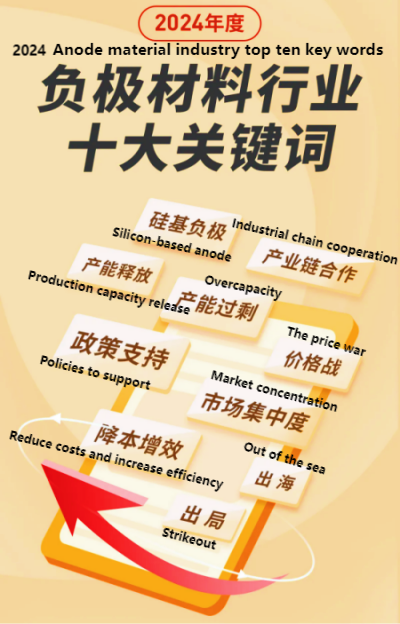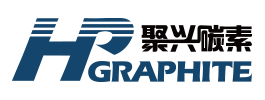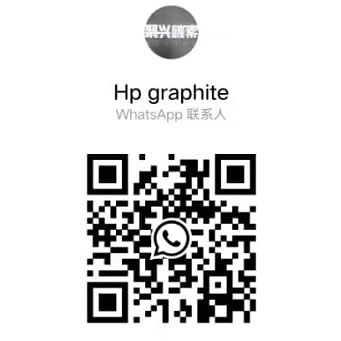【Anode】Top 10 Keywords for the Anode Material Industry in 2024

【Anode】Top 10 Keywords for the Anode Material Industry in 2024
In 2024, the anode material industry demonstrated steady growth, driven by technological innovation and policy support. The rise in new energy vehicle (NEV) sales spurred an increase in shipments of lithium battery anode materials. The industrialization of silicon-based anodes accelerated significantly, with their market penetration expected to rise. Silicon-based anodes are considered the most promising next-generation anode materials. The government has introduced a series of policies to support the development of the new energy materials industry, creating a favorable development environment and market demand for the anode material industry. Positive news in the negative electrode market drives up demand for supporting graphite materials.

Policy Support
Industrial Structure Adjustment Guidance Catalogue (2024 Edition): Lists key components for NEVs, including cathode and anode materials for power batteries, as encouraged projects, indicating government support for the anode material industry.
Lithium Battery Industry Specification Conditions (2024 Draft for Comments): Guides enterprises to reduce capacity-expansion manufacturing projects, enhance technological innovation, improve product quality, and lower production costs. It also sets further requirements for the production processes, operational standards, and energy-saving measures for anode materials.
2024-2025 Energy Saving and Carbon Reduction Action Plan: Aims to achieve China's energy-saving and carbon-reduction goals during the "14th Five-Year Plan" period, indirectly benefiting the silicon-carbon anode material industry.
Overcapacity
Although end markets like NEVs drove growth in demand for anode materials in 2024, the growth rate fell short of market expectations, leading to underutilized capacity. Large cylindrical batteries (46 series) failed to achieve mass production, and semi-solid-state batteries, which gained traction in recent years, also did not reach large-scale production. Consequently, current demand remains concentrated in the consumer market and overseas cylindrical power batteries. From January to October, domestic shipments of anode materials reached 1.65 million tons, but the overall market continues to face oversupply challenges.
Capacity Expansion
The growth of anode material capacity continued in 2024, albeit at a slower rate compared to previous years. This slowdown is primarily due to an oversupply in the industry, prompting some companies to delay expansion plans and reduce new capacity development. Despite this, according to incomplete statistics, approximately 1.5 million tons of anode material capacity are expected to be released in 2024. These capacities are mainly concentrated in previously planned expansion projects.
Examples of newly operational projects include:
Phase I of BTR's intelligent integrated anode factory in Yunnan.
Full-scale operation of Shanshan's integrated anode material project in Yunnan.
Sichuan Zichen's 200,000-ton/year lithium battery anode material production line.
Sinatech's 100,000-ton/year integrated anode material project, set to launch by year-end.
Sichuan HaiChuangShangWei's 100,000-ton/year integrated power and energy storage battery anode material project.
Baofeng's battery material industrial chain demonstration project, which includes anode materials.
Chongqing JinHuiNeng's 100,000-ton lithium battery anode material production base.
Cost Reduction and Efficiency Enhancement
In response to fierce market competition and price challenges in 2024, several companies adopted cost reduction and efficiency improvement measures to strengthen their competitiveness.
BTR: Announced plans to increase anode material shipments while implementing significant technological innovations and cost reduction initiatives.
Shanshan: Improved its self-sufficiency in graphitization through integrated projects and leveraged new box furnace technology to reduce costs further.
Putailai: Focused on deploying advanced technologies to improve production efficiency, enabling effective cost reduction in the graphitization process and enhancing profitability. Additionally, it pursued product differentiation to capture market opportunities with leading clients.
Overseas Expansion
The rapid expansion of production capacity in recent years has intensified domestic competition in the anode material industry. In contrast, overseas markets present significant growth potential. The global NEV market penetration rate is only 18.3%, much lower than China's rate of over 30%, indicating sustained growth in overseas demand for NEVs and supporting materials.
Domestic anode material manufacturers are accelerating overseas factory construction to better serve local clients. Notable projects include:
China Carbon's 100,000-ton/year anode material project in Morocco.
Putailai's integrated base in Sweden, with a planned capacity of 100,000 tons.
Shanshan's 100,000-ton project in Finland.
Market Concentration
The market concentration of lithium battery anode materials remains high. Leading companies like BTR, Shanshan, Putailai, Sinatech, China Carbon, and Xiangfenghua entered the sector early, establishing competitive advantages in technology, client resources, and cost efficiency.
Key performance highlights include:
BTR: Over 200,000 tons shipped (+18.96% YoY).
Shanshan: Approximately 160,000 tons shipped (+50% YoY).
China Carbon: 92,000 tons shipped (+52.86% YoY).
Sinatech: 83,800 tons shipped (+59.34% YoY).
Silicon-Based Anodes
Prominent projects include Inner Mongolia Silan Energy's Phase I 20,000-ton/year silicon-carbon anode material project, which utilizes the silane CVD process. BTR continues to lead the industry with a 70% market share in silicon-based anode materials in the first half of 2024.
Industry Collaboration
Upstream materials for anode production include graphite, petroleum coke, needle coke, pitch coke, silica, and lithium salts. Downstream applications cover power, consumer, and energy storage lithium batteries.
Sinopec, together with Guangdong Kejin New Energy, announced a strategic partnership to develop innovative technologies for anode materials, supporting advancements in the "needle coke-anode material-lithium battery" supply chain.
Price Wars
Anode material prices showed mixed trends in 2024. While prices rebounded slightly in H1 due to adjustments by major clients, they declined in Q3 as production increased. Current average prices are around CNY 32,000/ton, down 12% YoY. Intense price wars further compressed profit margins, particularly for mid- to low-end products. Industry experts anticipate a price recovery in 2025.
Market Exits
Amid an extended downturn, the industry underwent significant consolidation. It is estimated that over 40 companies will exit the market in 2024, driven by excess supply, low capacity utilization (around 50%), and ongoing price wars. The trend toward market concentration and technological upgrades continues to favor leading companies, leaving less competitive firms struggling to survive.
Feel free to contact us anytime for more information about the artificial graphite anode market. Our team is dedicated to providing you with in-depth insights and customized assistance based on your needs. Whether you have questions about product specifications, market trends, or pricing, we are here to help.
No related results found








0 Replies